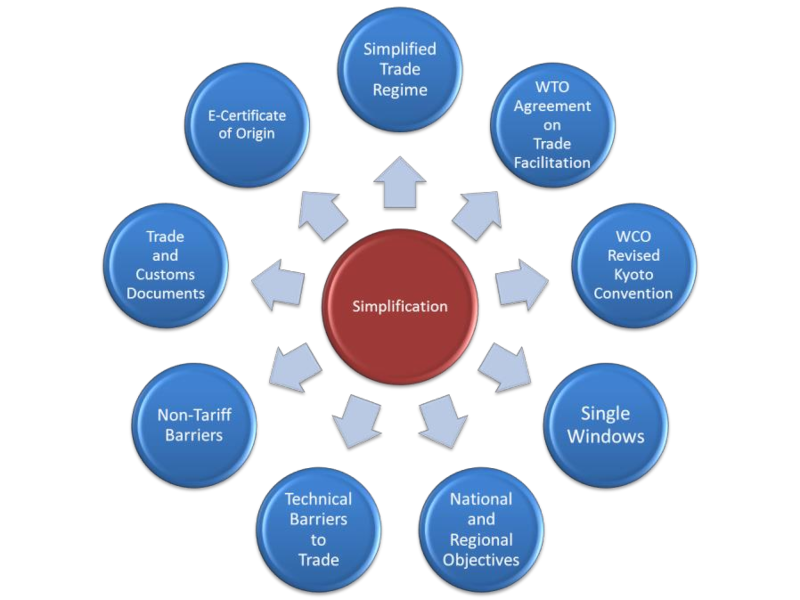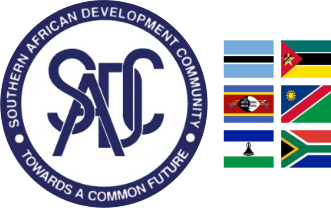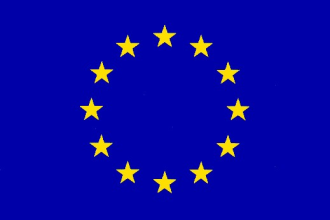The purpose of activities in the simplification cluster is to ensure that trade laws, regulations, administrative guidelines, and processes are simplified as much as possible so goods are cleared without undue burden. The figure below summarises activity areas.

Simplified Trade Regime for Small Scale Traders
The SADC Protocol on Trade, Annex III, Article 2 states, “The objective of this Annex is to promote cooperation among Member States in simplifying and harmonizing trade documentation and procedures for the purpose of facilitating intra-SADC trade.” The Revised RISDP includes developing and implementing a simplified cross border trading regime by 2018 as one of the Selected Target Outputs. Further, Article 10, paragraph 1 of the WTO TFA calls for members to review formalities and documentation to reduce and simplify requirements related to importation, exportation and transit. This review process is intended to address customs and other trade agency requirements in order to minimize the incidence and complexity of formalities and required documentation.
A number of studies estimate that the simplification and streamlining of documentation requirement and formalities for importation/exportation can significantly reduce transaction costs associated with formal trade. These measures are particularly important for small scale cross border traders who often have to deal with complex administrative requirements. Moreover, for small or low value consignments the costs of complying with complex requirements and formalities may be disproportionate relative to the transaction value. In line with the Protocol on Trade, the Revised RISDP and the WTO TFA; the implementation of simplified trade procedures for eligible small scale traders will help to boost intraregional trade leading to economic growth in the region.
In 2010, the EAC Secretariat implemented a simplified trade regime at border entry points to support small scale traders. The EAC has been implementing uniform Rules of Origin for the granting of preferential treatment to goods originating from the region. In order to facilitate cross border trade, the EAC developed a simplified EAC Certificate of Origin to be used by small scale cross border traders. This instrument has simplified trade along the borders.
In developing a regime, SADC Member States needs to review or request technical assistance to assess the current procedures for small formal and informal cross border traders. Additionally, SADC [Secretariat] should review the regimes and STR instruments in the EAC and COMESA including the simplified certificate of origin. These reviews should be used to develop a simplified procedure including minimum document requirements for the SADC region. The procedures need to include not only customs but other agency procedures and take into account the expectations of the small cross border traders. Further, automation and infrastructure issues such as possible dedicated lanes needs to be determined. Draft legal requirements need to be considered also prior to submitting the regime to the Member States for approval.
Implementation of WTO Trade Facilitation Agreement
The WTO TFA has provisions for special and differential treatment for developing and least developed countries. These provisions constitute an agreement by donor countries to provide technical assistance and training to implement TFA provisions. Simply put, if the economic benefits of the WTO TFA are to be achieved, donors and recipient countries will need to work together.
The WTO TFA says that developing and least developed country Members should be provided technical, financial, or any other mutually agreed type of assistance to help them implement the agreement and specific provisions in three categories:
- Category A. Provisions that developing countries designate for implementation upon entry into force of the agreement and least developed countries designate for implementation within one year of that date.
- Category B. Provisions that developing and least developed countries designate for implementation on a date after a transitional period following the entry into force of the agreement.
- Category C. Provisions that developing and least developed countries designate for implementation on a date after a transitional period which requires the acquisition of implementation capacity through the provision of assistance and support for capacity building.
Priorities and categorization must be based on self-assessments by each country.
Between 2007 and 2013, the WTO, WCO, and other donor partners supported assessments. These helped government agencies and private sector stakeholders understand how to prioritize proposals that can be implemented when the TFA is in force and how to distinguish them from those that will require more time and/or technical assistance to implement.
The TFA provides notification requirements and procedures for each category. These include information on technical assistance and support for capacity building when it is determined to be necessary.
The SADC Trade Protocol does not address several of the Articles in the WTO TFA. But Annexes II and III involve adopting and incorporating internationally accepted standards and guidelines; for instance, the WTO and WCO, for facilitating trade documentation and procedures in Member States’ customs laws.
Although the WTO TFA is to be implemented at the national level, SADC [Secretariat] is expected to support Member States in meeting requirements and realizing the benefits of the agreement. Support could take many forms; technical assistance, training, promotion of engagement or cooperation, guidance, production of regional standards, harmonization of strategic measures, assumption of responsibility for coordination functions, adoption of monitoring and evaluation obligations. SADC [Secretariat] should engage with UNCTAD as they are already providing support to some Member States (e.g., Angola, Botswana, Mauritius, Swaziland and Tanzania).
As a first step, SADC [Secretariat] needs to assist Member States that have notcompleted a self-assessment. It also needs to assist Member States with the notification of prioritized provisions for Category A and then Categories B and C. With these two tasks completed, Member States will be able determine where they stand in implementing TFA provisions and SADC [Secretariat] will be able to create a benchmarking matrix of problems common in Member States and of areas needing regional or donor assistance.
The WTO TFA presents an opportunity for SADC supplement Member States’ implementation by cultivating specific interventions associated with TFA measures that have regional implications and that could be supported at the national level through regional implementation. These opportunities (e.g., AEO, advance rulings, risk management) are outlined in Section 5.3; predictability cluster.
Member State Full Accession to Revised Kyoto Convention
Twelve SADC Member States are contracting parties to the RKC. Only Malawi and Zimbabwe have accepted all specific annexes and chapters without reservation; the other 10 have accepted only the General Annex (the minimum required). Angola, Seychelles and Tanzania have yet to accede. Accession of the Democratic Republic of the Congo is not yet ratified.
At the request of customs administrations, the SADC Secretariat has provided technical assistance to Angola, Democratic Republic of Congo, Seychelles, and Tanzania to identify legal gaps in meeting the standards set in the RKC. The Member States assisted are taking steps to either accede to the RKC or to ensure that their laws and procedures are compliant.
The WCO Mercator Programme was launched to support implementation of the WTO TFA. Support and technical assistance for modernization in priority areas is provided to SADC Member States through the WCO East and Southern Africa Regional Office for Capacity Building (ESA ROCB). An assessment carried out in 2014 found that Member States needed help in implementing the RKC. Assistance will be provided through workshops, consulting missions, and political engagement. SADC [Secretariat and Member States] has an opportunity to cooperate with the ESA ROCB to ensure that common aims and objectives are met.
SADC should enquire on the status of the Member States, except Malawi and Zimbabwe, to determine the status of acceptance of specific annexes and chapter or a timeline for acceding/ratification to the convention. SADC [Secretariat] should also extend more technical assistance where needed to ensure full accession in the SADC region.
Single Windows
Article 10, Paragraph 4 of the WTO TFA provides that
Members shall endeavor to establish or maintain a single window, enabling traders to submit documentation and/or data requirements for importation, exportation or transit of goods through a single entry point to the participating authorities or agencies. After the examination by the participating authorities or agencies of the documentation and/or data, the results shall be notified to the applicants through the single window in a timely manner.
In the border agency coordination section of its latest Notes on Trade Facilitation Measures, UNCTAD says that integration of border agency operations should begin with mapping and analysis of each agency’s mandate, procedures, and operations, and that findings be the basis for new joint operations. UNCTAD goes on to suggest that common documents and integrated procedures be based on joint procedures; that a system to monitor traffic flow and delays be designed to measure the impact of changes and identify bottlenecks at the border; and that a new ICT environment such as a single window platform - be used to share data among agencies and departments operating at the border. Indeed, interagency and trade cooperation are essential to single windows.
SADC could work with a Member State to implement a single window application leading to a regional single window. Much depends on establishing interconnectivity in Member States and regionally and the implementation of national single windows will facilitate this effort. Certain TFP activities are essential if SADC and Member States are to establish a single window at national or regional levels. SADC needs to complete these essential activities and resolve interconnectivity issues in order to plan for a regional single window application.
Technical Barriers to Trade and Sanitary and Phytosanitary Measures Technical regulations and SPS measures are non-tariff barriers if they are unjustified for health or safety reasons. Further, health and safety measures should be chosen to be minimally trade-distorting. The reduction of technical measures that are barriers to trade is a crucial issue that requires elaboration.
While technical measures have legitimate social objectives of protecting health, safety and the environment, if they are unjustified or unnecessary for health or safety they are non-tariff barriers (NTBs) to trade. NTBs will raise the cost of living, reduce access to key inputs, and increase the cost of doing business and hurt competitiveness and diversification. In addressing the trade restricting aspects of technical measures, however, it is important to recognize that countries have the right and the obligation to protect their citizens from unsafe or unhealthy products and the right to protect their environment and livestock against introduction and spread of plant pests and animal diseases. That is, there is a legitimate regulatory function to these types of regulations.
The WTO has the SPS Agreement on the Application of Phytosanitary Measures, which focuses on agricultural goods, and the TBT Agreement, which focuses on industrial goods. SPS measures are typically mandatory regulations that are enforced by agencies responsible for food safety, animal or plant health. TBT measures on goods are often voluntary (called standards in these cases), but can be mandatory technical regulations. WTO principles require that technical regulations or SPS requirements be adopted with minimum trade distorting implications, be science based and not discriminate against imports.
A non-tariff measure (NTM) becomes a non-tariff barrier (NTB) to trade when it is more trade restrictive than what is required to meet the acceptable level of protection requirements of the country or discriminates against imports. Imports that meet acceptable level of protection for health or safety should be permitted, regardless of how they achieve that standard. Market forces are best suited to determine quality; so technical regulations or SPS requirements should not be used to restrain imports based on quality considerations unrelated to health or safety considerations.
Annexes on technical barriers to trade (TBT Annex) and on sanitary and phytosanitary measures (SPS Annex) to the SADC Protocol on Trade were approved in 2008 and revised in 2014. The strengthening of a regional coordination mechanism for TBT matters and implementation of the TBT Annex is ongoing under the FTA Consolidation Action Plan. Regional coordination has been enhanced on SPS matters through the 2015 SADC Strategies on the Application of Plant, Animal, and Food Safety measures developed to support the further implementation of the WTO Agreement on the application of Sanitary and Phytosanitary (SPS) measures and the SPS Annex to the SADC Protocol on Trade.
The three strategies are intended to provide a practical, implementable and effective regional strategy to facilitate regional and international trade in plants and plant products, animals and animal products, and food products while ensuring the protection of human and animal life or health within Member States.
The focus for SPS is harmonization and implementation of measures in the food and agricultural sectors (including forestry and fisheries); and for TBT issues is support for regional accreditation, metrology, and standards harmonization. These initiatives are ongoing and therefore no timeline leading to the SADC Customs Union is assigned to this area. SADC [Secretariat] must ensure that a mechanism is in place to properly identify SPS/TBT issues and evaluate progress in TBT and SPS areas.
The TFP programme objectives for SPS/TBT should reflect the requirements to:
- Establish a database of all SPS/TBT issues in all Member States reporting toSADC;
- Perform an analysis of those SPS/TBT issues to determine validity of the measure and highlight issues that constitute a Non-Tariff Barrier (NTB);
- Develop an Action Plan to mitigate/eliminate the NTB issue within a prescribed period of time;
- Implement the NTB Action Plan as a component of the SADC Member State’s TFA compliance strategy; and
- Develop a Monitoring/Evaluation Strategy and Plan to track progress on the SPS/TBT reporting to SADC and organizations such as WTO, OIE (World Organization of Animal Health), FAO/WHO Codex (Food and Agriculture Organization/World Health Organization) and IPPC (International Plant Protection Convention).
Nontariff Barriers and Trade Monitoring and Compliance Mechanism
Article 6 of the SADC Protocol on Trade provides for reduction and eventual elimination of NTBs. Established in 2007, the Trade Monitoring and Compliance Mechanism (TMCM) enables reporting, monitoring, and elimination of NTBs. Since 2007, attention on NTBs has intensified and improvements have been noticeable. Most Member States now monitor NTBs and the SADC Secretariat continues to facilitate training in the TMCM and to sensitize Member States on types of NTBs. The importance of trade monitoring is recognized with full implementation of the TMCM included as an expected outcome/output in the SADC Industrialization Strategy roadmap.
NTBs may be found in the following areas:
- SPS measures,
- Technical Regulations,
- Pre-Shipment Inspections,
- Price Control Measures,
- Quotas, Licenses, Prohibitions and QRs,
- Charges, taxes and para-tariff measures,
- Finance measures,
- Anti-competitive measures,
- TRIMs,
- Distribution restrictions,
- Restrictions on post-sales services,
- Subsidies, excluding export subsidies,
- Government procurement restrictions,
- Intellectual property,
- Rules of origin, and
- Export measures, including export subsidies.
Progress in eliminating some longstanding NTBs however, remains slow. SADC is developing proposals to strengthen the online mechanism (e.g., following up consistently on posted complaints, removing resolved and non-actionable reports from the system). It has also been proposed that employees who deal with trade issues in Member States and at SADC be assigned the task of addressing NTBs. SADC [Secretariat and Member States] needs to ensure regular reports on TMCM implementation are being provided so it can assess the mechanism’s effectiveness and ensure timely resolution of reported NTBs.
Article 10(5) of the WTO TFA states that ‘members shall not require the use of preshipment inspections in relation to tariff classification and customs valuation’. Therefore, there is a need for SADC to sensitize Member States to eliminate the use of preshipment measures for these customs procedures and to encourage the abolition of private companies being appointed to inspect goods in addition to government agencies.
Trade and Customs Documents
During its 12th meeting held in March 2014, the SADC Subcommittee on Trade Facilitation directed the Secretariat to assess trade documents used in SADC. This work is ongoing. SADC should continue to conduct an inventory of trade and customs documents to identify which can be standardized and promoted. The exercise must take into account the models based on the UN Layout Key and the data elements requirements based on the WCO Data Model. In addition, COMESA and EAC documents should be reviewed for standardization in anticipation of the Tripartite Free Trade Agreement.
Electronic Certificate of Origin
The SADC Secretariat has run workshops on e-certificates for Botswana, Malawi, Namibia, Swaziland, and Zambia. Workshops in other Member States are ongoing. Workshops are to be followed by a pilot run and implementation. Implementation will require an amendment to Annex I (rules of origin) of the Protocol on Trade. SADC [Secretariat] should enquire as to the readiness of Member States to have a pilot run, monitor the results of the runs, and draft an amendment to Annex 1 in preparation for implementation. After implementation, a mechanism should be developed to monitor the programme with periodic outcome reports.
Linked to e-certificates, SADC is reviewing its rules of origin, with Member States doing national consultations. This review has been underway for some time and latest expectations were for it to be concluded in March 2015 but a conclusion is not in sight. The review is identified in the revised RISDP as one of the Selected Target Outputs to be completed by 2019. Continuation of the review should be a sub-activity under this Simplification Cluster activity.
Melding National Priorities with the Regional Objectives
Integration to a Tripartite Free Trade Area and to a SADC Customs Union are an enormous task. SADC [Structures, Secretariat and Member States] must ensure that a mechanism is in place to document Member States’ goals and initiatives for trade facilitation and then align them with regional strategic plans. This will reduce conflicts between national and regional goals. Future regional and national initiatives and interventions must take into account TFP activities to prevent duplication of effort. facilitation and then align them with regional strategic plans. This will reduce conflicts between national and regional goals. Future regional and national initiatives and interventions must take into account TFP activities to prevent duplication of effort.


